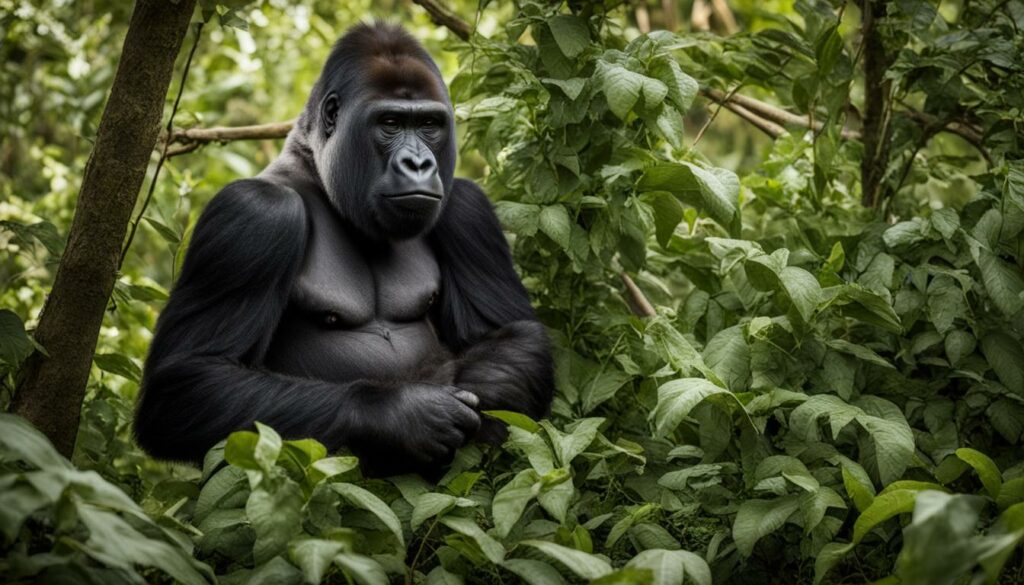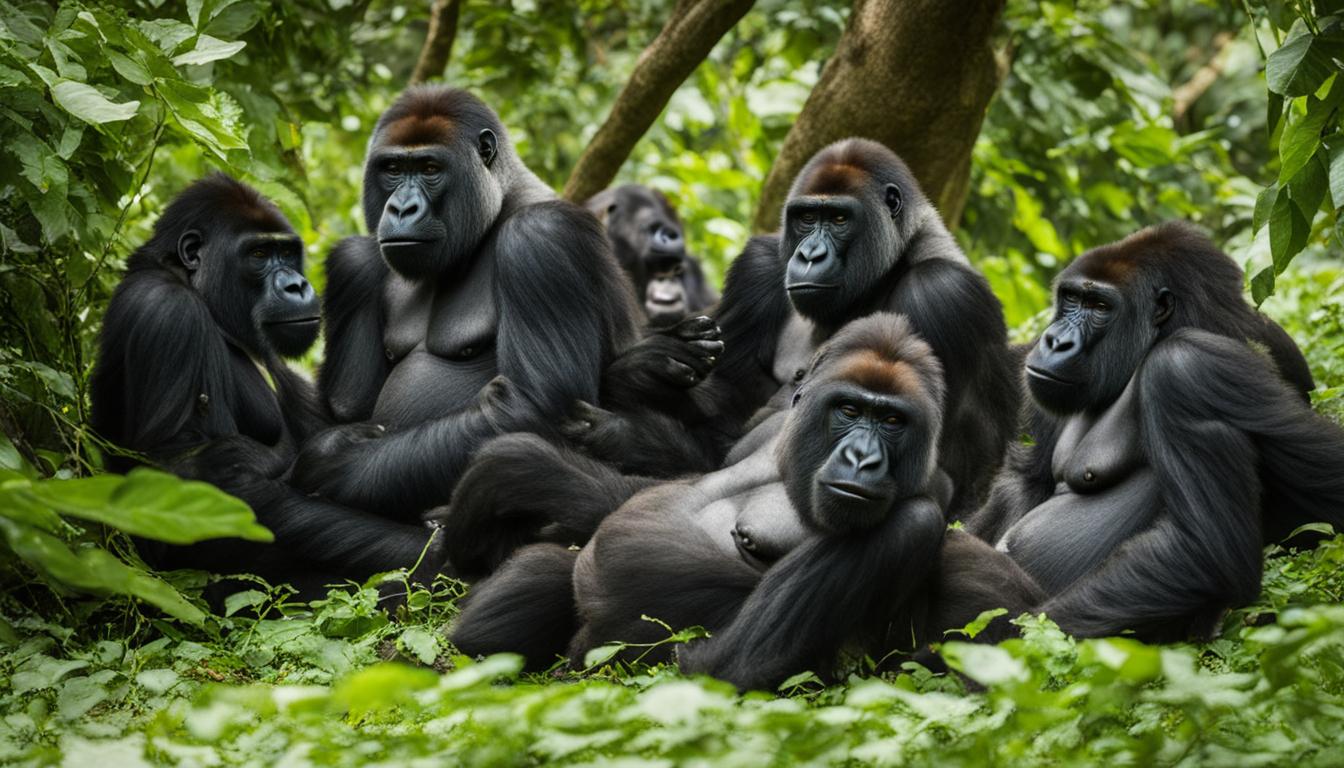Gorillas display distinct behavior patterns both in the wild and in captivity. In the wild, gorillas live in troops consisting of adult males (silverbacks), juvenile males (blackbacks), adult females, and young. The dominant silverback is responsible for the safety and protection of the troop. Gorilla behavior includes chest-beating, vocalizations, and displays of aggression when threatened. In captivity, gorillas are observed to exhibit similar behaviors, but their interactions are influenced by the enclosure design, composition of the group, and visitor presence.
Social Interactions and Family Dynamics
Gorillas have a complex social structure within their troops. The dominant silverback plays a crucial role in maintaining order and making decisions for the group. He has exclusive breeding rights to the adult females, ensuring the survival of his genetic lineage. The silverback also provides protection and security for the troop, utilizing displays of aggression when necessary.
Adult females in the troop compete for grooming and proximity to the silverback, as it enhances their social status. They form strong bonds with their offspring and play an important role in their development. Mothers are highly protective of their young and provide constant care and guidance. The close bond between mother and child is evident in their gentle and nurturing interactions.
“The social structure of gorilla troops is similar to that of human societies, with dominant individuals presiding over the group and females competing for resources and status.” – Jane Goodall
Gorillas use a variety of non-verbal behaviors to communicate and reinforce social bonds. Nose-to-nose greetings and embracing are common displays of affection and reassurance. These interactions help maintain the harmony within the troop and strengthen the social fabric. However, aggression can also occur, particularly between silverbacks competing for breeding opportunities.
Table: Gorilla Social Interactions and Family Dynamics
| Social Dynamics | Description |
|---|---|
| Role of the Dominant Silverback | Leader of the troop, responsible for breeding, decision-making, and protection |
| Competition among Adult Females | Grooming and proximity to silverback to enhance social status |
| Mother-Offspring Bond | Mothers provide constant care and guidance to their young |
| Non-Verbal Communication | Nose-to-nose greetings, embracing, and other displays of affection and reassurance |
| Aggression between Silverbacks | Competition for breeding opportunities can lead to aggressive interactions |
Understanding gorilla social interactions and family dynamics is crucial for their management in captivity. By creating environments that foster natural behavior and provide opportunities for social engagement, we can ensure the well-being of these magnificent primates.
Gorilla Feeding Habits and Foraging Behavior
Gorillas, being herbivores, have distinct feeding habits and foraging behavior. They spend an average of 14 hours a day foraging for food in their natural habitats. Gorillas have a diverse diet that includes leaves, stems, fruits, and bark from various plant species. They are known to consume over 100 different types of plants, demonstrating their adaptability to different environments. Despite their large size, gorillas are not known to compete for food resources within their troops. Unlike some other primate species, they typically do not share their food with others, foraging individually or in small family groups.
Feeding activity for gorillas is influenced by the availability of food resources. Their daily activity patterns typically involve peak feeding periods in the early morning and evening when preferred food items are abundant. During these times, gorillas can be observed actively searching for and consuming their preferred plant species. Gorillas use their dexterous hands to pick and manipulate vegetation, displaying their incredible strength and coordination. They also show selective feeding behavior, choosing certain parts of plants based on their nutritional content and palatability.
Comparison of Gorilla Feeding Habits in the Wild and in Captivity
| Feeding Habits | Wild Gorillas | Gorillas in Captivity |
|---|---|---|
| Food Source | Wide variety of plants | Commercially prepared diets supplemented with fruits and vegetables |
| Food Availability | Dependent on seasonal changes and local habitat conditions | Provided by caretakers on a daily basis |
| Feeding Time | Peak activity in the early morning and evening | Consistent daily feeding schedules |
“Gorillas have evolved a specialized digestive system to process their herbivorous diet, efficiently extracting nutrients from plant materials. Their feeding habits are not only essential for their survival but also play a vital role in shaping their natural habitats, as they contribute to seed dispersal and vegetation growth.”
It is important to consider these feeding habits when managing gorillas in captivity. Providing a diet that mimics their natural food sources and ensuring a consistent schedule can help promote their physical and psychological well-being. Environmental enrichment activities that encourage foraging behavior, such as hiding food or presenting it in puzzle feeders, can also provide mental stimulation and prevent boredom.
Understanding the feeding habits and foraging behavior of gorillas is crucial for their overall care and conservation. By replicating their natural feeding experiences as closely as possible and promoting a diverse and nutritious diet, we can support the health and welfare of these magnificent primates.
Mating Rituals and Reproduction
Gorillas have unique mating rituals that are influenced by their social structure and hierarchy within the troop. The dominant silverback, as the leader of the group, has exclusive breeding rights to the females. He initiates mating by performing displays of dominance, such as chest-beating and vocalizations, to assert his authority. Adolescent females often leave their natal troop to join other troops before reproducing, while males usually disperse from their parental group to form their own troops.
Female gorillas typically give birth for the first time around the age of 8. The gestation period for gorillas is approximately 8.5 months, similar to humans. After giving birth, the mother forms a strong bond with her offspring and provides them with constant care and protection. The young gorilla relies heavily on its mother for nourishment and guidance during the early years of its life.
The reproduction of gorillas is a crucial consideration in both the wild and captive settings. In the wild, understanding mating rituals and reproduction helps in managing population dynamics and ensuring the survival of the species. In captivity, it plays a vital role in the implementation of successful breeding programs to sustain genetically diverse populations and maintain the long-term health of captive gorilla populations.
Table: Comparison of Gorilla Mating Rituals
| Aspect | Wild Gorillas | Gorillas in Captivity |
|---|---|---|
| Mating Initiation | Initiated by dominant silverback through displays of dominance | Depends on the dynamics of the captive group and the recommendations of the breeding program |
| Female Maturity | Adolescent females transfer to new troops before reproducing | Depends on the specific guidelines and requirements of the breeding program |
| Male Dispersal | Males leave their parental group to form their own troops | May or may not be applicable, depending on the captive group dynamics and recommendations |
| Offspring Care | Mothers provide constant care and nourishment to their offspring | Depends on the specific guidelines and recommendations of the captive facility |
The table above provides a comparison of gorilla mating rituals in the wild versus captivity. It highlights the differences in mating initiation, female maturity, male dispersal, and offspring care between these two settings. Understanding these variations is crucial for managing gorilla populations effectively and promoting successful reproduction in both the wild and captive environments.
Intelligence and Play Behavior
Gorillas are known for their exceptional intelligence, making them one of the most fascinating primate species. Their cognitive abilities have been extensively studied and have revealed remarkable problem-solving skills and tool usage. Gorillas have been observed using sticks as tools to extract insects from tree crevices and using rocks as tools to crack open nuts. These behaviors demonstrate their ability to analyze their environment and develop innovative solutions to meet their needs.
Furthermore, gorillas exhibit complex communication skills and social interactions that require a high level of intelligence. They use a variety of vocalizations, facial expressions, and body postures to convey messages and maintain social cohesion within their troops. Research has shown that gorillas can understand symbolic communication, such as using sign language or pictorial symbols, to communicate with humans.
“Gorillas possess a level of intelligence that continues to amaze researchers. Their ability to problem-solve and communicate is a testament to their cognitive capabilities.”
Play behavior is another important aspect of gorilla behavior, particularly among young individuals. Playful interactions among gorillas help them develop crucial social and cognitive skills. They engage in activities such as chasing, wrestling, and mock fighting, which not only promote physical fitness but also strengthen social bonds within the troop. Play also provides opportunities for learning and exploration, allowing young gorillas to acquire essential life skills in a safe and supportive environment.
In conclusion, gorillas exhibit remarkable intelligence and play behavior. Their cognitive abilities, problem-solving skills, and communication capabilities contribute to their adaptability and success in their natural habitats. Understanding the intelligence and play behavior of gorillas is not only crucial for their well-being in captivity but also for the conservation and management of wild populations.

| Intelligence | Play Behavior |
|---|---|
| Gorillas display exceptional problem-solving abilities and tool usage. | Gorillas engage in playful interactions to develop social and cognitive skills. |
| Gorillas can understand and use symbolic communication. | Play behavior strengthens social bonds within the troop. |
| Their cognitive capabilities contribute to their adaptability in their natural habitats. | Play provides opportunities for learning and exploration. |
Conclusion
Gorilla behavior is fascinating to observe, both in the wild and in captivity. Their social interactions and family dynamics are complex, with dominant silverbacks leading the troops and adult females competing for grooming and proximity to the leader. Non-verbal communication, such as nose-to-nose greetings and embracing, is essential for gorillas to convey reassurance and maintain social bonds.
Feeding habits and foraging behavior play a significant role in the daily lives of gorillas. Spending about 14 hours a day foraging for plants, these herbivores consume a variety of vegetation. They construct nests to rest in at night, using vegetation as bedding. Gorillas are intelligent creatures capable of problem-solving, tool use, and understanding symbolic communication. Playful interactions contribute to their cognitive and social development, enhancing their overall well-being.
Understanding gorilla behavior is crucial for managing their populations, both in the wild and in captivity. It is important to respect their natural behavior and create environments that cater to their specific needs, ensuring their physical and psychological well-being. By providing appropriate social interactions and enrichment opportunities, we can promote the welfare of gorillas and contribute to the conservation of these magnificent creatures.
Do Gorillas Exhibit Different Behaviors in Captivity Compared to the Wild?
Gorilla interactions in the wild are significantly different from those in captivity. In the wild, gorillas exhibit natural behaviors, such as foraging for food and building nests. However, in captivity, gorillas may display different behaviors due to limited space and artificial environments.
FAQ
What are some common behaviors exhibited by gorillas?
Gorillas display chest-beating, vocalizations, and aggression when threatened.
What is the social structure within a gorilla troop?
Gorilla troops consist of adult males (silverbacks), juvenile males (blackbacks), adult females, and young. The dominant silverback is responsible for the safety and protection of the troop.
How do gorillas communicate with each other?
Gorillas use non-verbal behaviors, such as nose-to-nose greetings and embracing, to communicate and provide reassurance to one another.
What do gorillas eat and how do they obtain their food?
Gorillas have a herbivorous diet and consume a variety of plant species, including leaves, stems, fruits, and bark. They spend about 14 hours a day feeding and foraging.
How do gorillas mate and reproduce?
The dominant silverback has breeding rights to the females and initiates mating. Female gorillas usually give birth for the first time around the age of 8.
Do gorillas exhibit intelligent behavior?
Yes, gorillas are highly intelligent primates. They can solve problems, use tools, and understand symbolic communication.
Why is play behavior important for gorillas?
Play behavior is important for gorillas, especially among young individuals, as it helps develop social and cognitive skills, strengthens bonds within the troop, and provides opportunities for learning and exploration.
How can we promote the well-being of gorillas in both wild and captivity?
By respecting their natural behavior and providing appropriate social interactions and enrichment opportunities, we can ensure the welfare of gorillas in both wild and captive settings.






